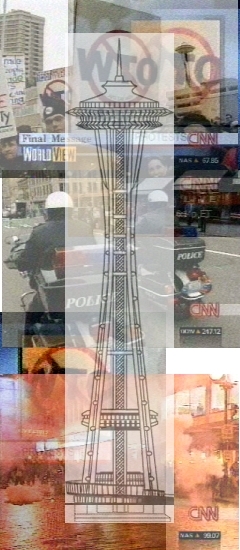
 |
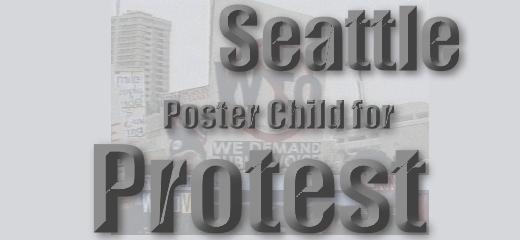 |
Seattle, November-December 1999: the third meeting of the Ministerial Conference of the World Trade Organization. President Clinton was the host. Political leaders came from around the world.
The news media -- global, national, and local -- were there in full force.
As were the protesters.
For the political leaders who believed that freer trade would improve their economies this was the place to be.
For those who believed that freer trade would have a detrimental impact on people and the environment this was, also, the place to be. It was the point of resistance.
For reporters and camera crews the conflict between leaders and protesters was the story of the week. Hence, it was the place to be for them, as well.
It was a combustible combination that moved arguments about the globalizing economy from arcane bits hidden on back pages to the center stage provided by global media. It took very little to produce the explosion.
The political leaders were besieged. Seattle was trashed. The police lost control -- over and over. For most of a week the airwaves were filled with stories about protest, demonstration, and clashing visions of the future in which the clash became very material.
What did the resistance become, now that it had reached center stage? How was the resistance characterized -- visually and orally? What did one learn about their objections and their aspirations?
On November 30, December 1, 2, and 3 WorldView devoted seventeen minutes and forty-four seconds to the conference. Eight minutes and forty-one seconds of President Clinton's opening address was broadcast live leaving nine minutes for news reporting. Five of the nine minutes was devoted to anchor persons, reporters, the mayor, the police chief, and a few others. Four minutes was devoted to pictures of the protesters.
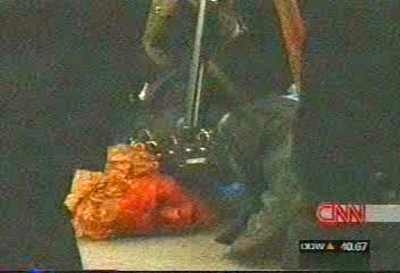 |
|
Click the image to go to the video: 0:46 seconds
|
The Dow was up 40 points. The protester was forced to the ground and held there by the police. Image analysis software identified more than 60 separate images in the four minutes of video. We extracted 46 of the images and made a video with each image displayed for a second.
Twenty were images of protesters marching or sitting. Two of these were specifically pictures of labor union members marching.
Another 21 were images of conflict between the protesters and the police. The protesters were pushed to the ground, dragged or carried, kicked in the groin, pushed with a night stick, threatened with a gun, and sprayed. Red light illuminated the use of a gas to quell the crowd.
There were four pictures of an individual talking. In three the audio was a person addressing an audience -- having his and her say. The fourth was a picture of two men talking, but the audio was a voice over by the reporter.
There were many marchers carrying signs, but the camera persons managed only a few shots in which one could make out the text on the signs.
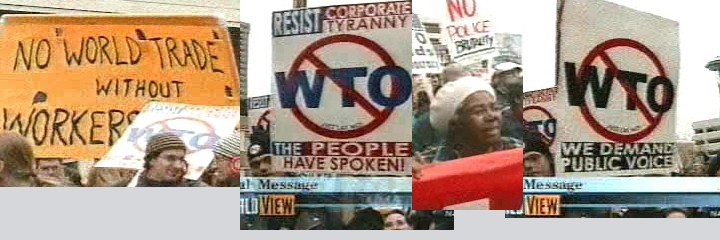 |
No world trade without workers. Resist corporate tyranny; the people have spoken. No police brutality. We demand public voice. The visuals did not carry much message -- other than the desire of the protesters for change and their willingness to take on the police in their commitment.
Self characterizations -- in the form of signs -- were in short supply in the visuals of the news broadcasts. There was, however, plenty of characterization in the talk of the broadcasters [partial text]. Time is in short supply in news broadcasting, and qualification and subtlety are in even shorter supply. The language is direct and strong. The protesters disrupted, prevented others, clashed. They damaged, overturned and confronted. Police had to regain control by cracking down, arresting because the protesters looted and vandalized. Their protests knew no boundaries as they broke through barriers.
'March' and 'rally' -- once each -- were the mildest characterizations of the activities of the protesters.
Almost completely missing was characterization of what the protesters were attempting to accomplish by taking to the streets.
PROTEST GROUPS SAY THEIR FOCUS IS STILL ON GETTING THE WTO TO CHANGE ITS LABOR AND ENVIRONMENTAL POLICIES.
THE PROTESTERS SAID THEIR GOAL WAS TO DRAW ATTENTION TO THE WTO.
This is something less than in depth coverage of the goals and hopes of the protesters. The same can be said for the meeting, however. Political leaders came from around the world to meet in Seattle. Aside from President Clinton's welcoming speech there was nothing about what they were doing in the meeting -- other than trying to get past the protesters.
Violence was broadcast around the world. Neither the work of the World Trade Organization nor the disagreements of the protesters could be heard.
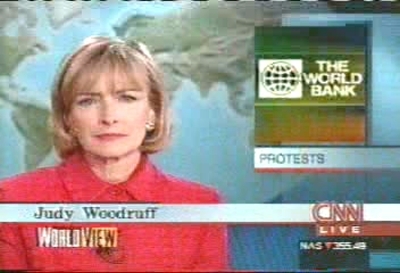 |
|
Click Image to go to Video 0:41 Seconds
|
 |
|
Click Image to go to Video 0:59
|
Seattle was an inflection point for protest against the globalizing economy. Judy Woodruff did not use that language, but it was the interpretation that she gave to these events.
Before Seattle the 2000 spring meeting of the World Bank would have not have been big news. After Seattle, however, it had become a major media event -- targeted by the protesters and watched closely by the global media. Before Seattle the protesters were not big news. Like the World Bank, they did not make it into the global news.
The 1998 May Day protest featured in WorldView is an example. There were protests in Germany, but WorldView showed a confrontation between neo-Nazis and leftists. Protests were in the news, but they were not 'resist globalization' protests.
The World Bank had been meeting since its inception -- only very occasionally making it into the news. The anti-globalization people had been slowly gathering steam; protesting here and there, but not making it into the global news. Seattle changed both. After Seattle the globalizing economy and the institutions promoting it and the groups protesting against it had become global news.
The table below shows the same pattern. The institutions that were or became the subject of global news were: May day, G8 meetings, the World Trade Organization ministerial meetings, meetings of the IMF and World Bank, meetings of the European Union, and meetings of the World Economic Forum. At one time or another these became the focus of protest and media coverage of the protest, but not before 1999. The media coverage of resisting globalization is Seattle and post-Seattle.
|
Global Media and Protesting the Globalizing Economy
|
||||||
|
Year
|
May Day
|
G8
|
WTO
|
IMF WorldBank
|
EU
|
WEF
|
| 1998 | ||||||
| 1999 |
+
|
|||||
| 2000 |
+
|
+
|
||||
| 2001 |
+
|
+
|
+
|
|||
| 2002 |
+
|
+
|
||||
| 2003 | ||||||
It is an unusual collection of occasions for protest and news coverage. May Day is a day; an international agreement to celebrate workers and their rights. There are three international organizations that convene political leaders of the world on a regular basis -- the World Trade Organization, the International Monetary Fund and the World Bank. There are meetings of national leaders -- the G8 and the EU annual meeting. Finally there is the World Economic Forum, which is a private organization meeting annually.
The meeting of the Ministerial Conference of the World Trade Organization was held in late November and early December of 1999. The next of these occasions was the meeting of the World Economic Forum in January. It is an international discussion organization. Some of the richest business people in the world get together with invited politicians and others once a year to take stock and interact with each other. How rich you have to be is reflected in the registration fee for the meeting, which was $20,000 in 1999.